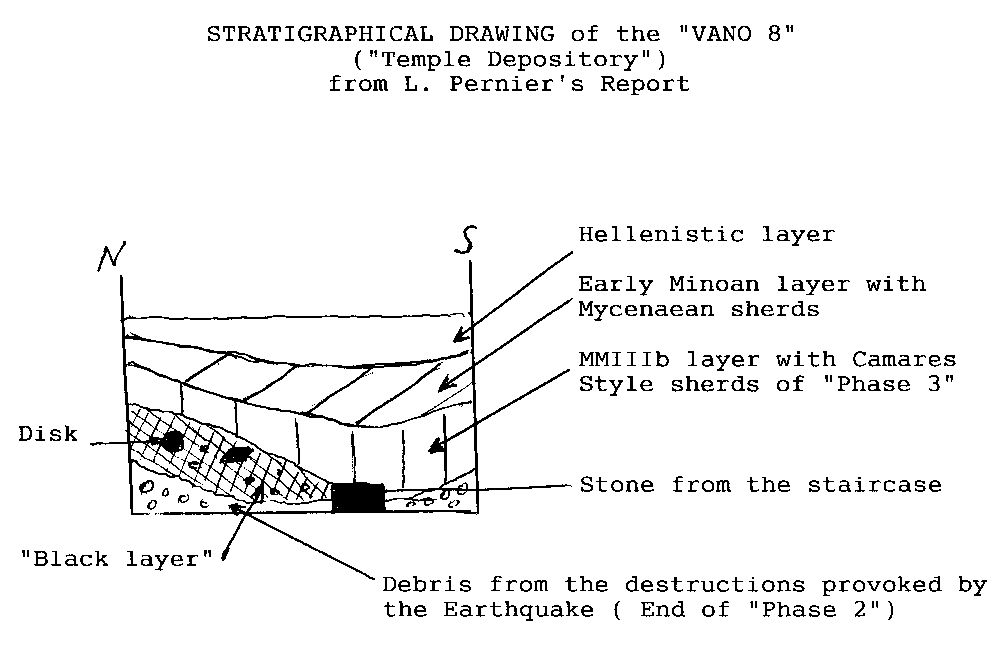 |
Reading this paper, I got the feeling that by favouring in his conclusion the "steatite hypothesis", the author has not paid sufficient attention to the fact that creating a drawing with embossed lines on a piece of steatite is a less logical process than filling a negative carved mould with a molten metal. On the other hand, the choice of gold as a metal -first proposed by L. Godart- has no solid ground. So, I wonder why Dr Rumpel has limited his tries to this metal, and didn't use also lead, silver or arsenical bronze, all solutions which seem more probable than gold in the prospect of the Cycladic, Proto-Ionian origin of the Disk (See Faucounau 2001).
But my main criticisms concern the three following points:
1)- ARCHAEOLOGICAL SURROUNDING OF THE DISK
In spite of quoting Y.Duhoux (1977), Dr Rumpel has not followed the definite conclusion of this author, who has made a very careful study of L. Pernier's diverse reports on his discovery. In the above cited book, Y. Duhoux wrote (p.14): "L'entourage direct du disque est exclusivement MM" ("The near surrounding of the disk was exclusively Middle Minoan").
It is true that this conclusion came from Pernier's description and not from a (non-existent) stratigraphical drawing. But, from Pernier's report, it is easy to "reconstruct" such a drawing, showing the undisturbed "black layer" in which the Disk was found (See Figure 1).
 |
Moreover, the Proto-Ionian decipherment of the Disk (See Faucounau 1999) and the work of F. Carinci (See Aegeum 3, pp.73-80) have allowed us to reconstruct the history of the "Vano 8" as follows: From its architectural characteristics, it has been established that this underground room was a "Temple Repository" (cf Pernier, Platon, Alexiou, etc.). It is in this basement that the Proto-Ionian Disk (coming from a tomb or a mortuary temple, pillaged by the Minoans in a Cycladic island) has been storaged as a trophy, with diverse precious items. When the Earthquake happened at the end of "Phase 2" (following F. Carinci's definition), the building above the Temple Repository was destroyed. A few days after the Earthquake, the Minoans sent a crew to clear up the room and to recover the precious objects. During this operation, the workers had their meals on the spot, so creating this "black layer" with charcoal, ashes and bovine bones, in which the Disk and the Linear A tablet PH 1 were found. The Disk, which had been discovered by the Minoan workers amongst the plaster debris, fallen from the ceiling and walls, was apparently discarded as worthless, and thrown into the "black layer" of ashes.
2)- EXISTENCE OF "OTHER DISKS"
Dr Rumpel wrote that "there has only one specimen of this kind of writing been found, which is a short text on a votive axe from Arkalochori cave on Crete. He also mentioned the fragment of clay from Vladikavkaz (Ossetia). Both examples are questionable. In both cases, the signs have not been printed, but engraved with a pointed instrument, so the scripts are not identical.
However, a few inscriptions, similar to the one from Arkalochori ("Dagger from Lachish", "Plate from Shechem", etc.) have been found in Palestine. In the frame of the "Proto-Ionian Theory", all those inscriptions can be explained as "Proto-Philistine", and the similarities of their script with the Phaistos Disk's signs are coming from the historical links between the Proto-Ionians and the later Philistines (See Faucounau 2001).
As for the "fragment from Vladikavkaz", there are very strong reasons to believe that it is a fake, fabricated in the 1920es.
3)- ORIGIN OF THE PHAISTOS DISK
Dr Rumpel mentioned "a probable Minoan origin of the Disk". His opinion cannot be sustained any more since the discovery of the existence of Proto-Ionians in the Aegean during the Early Bronze Age (See Faucounau 2001). I would like to point out here that if the Proto-Ionic decipherment of the Phaistos Disk has been subject to (superficial) criticisms from some Mycenaeologists, the evidence concerning the existence in the Aegean of Proto-Ionians since c.2900 BC has never been shown to be false. Therefore, it is legitimate to think -independently of the Proto-Ionic decipherment- that the Phaistos Disk is not Minoan, but Cycladic and Proto-Ionian. A lot of things go in this direction, as the type of script, the signs, etc. In particular, Dr Rumpel didn't pay sufficient attention, in my opinion, to the big difference between the Minoan seals and the Disk's stamps. All the Minoan seals have been carved in steatite or in some kind of hard stone. The Disk's stamps were "in relief", with a drawing made with embossed lines.
Of course I know Jean Faucounau's work on the Diskos of Phaistos and his special position regarding its origin and reading. Nevertheless, I should emphasize the fact that I dealt with mechanical production problems of the Disk. Faucounau's objections only touch some topics which I cursorily mentioned in the introduction and not the basics.
With one exception. He stated:
"the fact that creating a drawing with embossed lines on a piece of steatite is a less logical process than filling a negative carved mould with a molten metal."
To this I can only answer: "Well, do it, and report about your experience!"